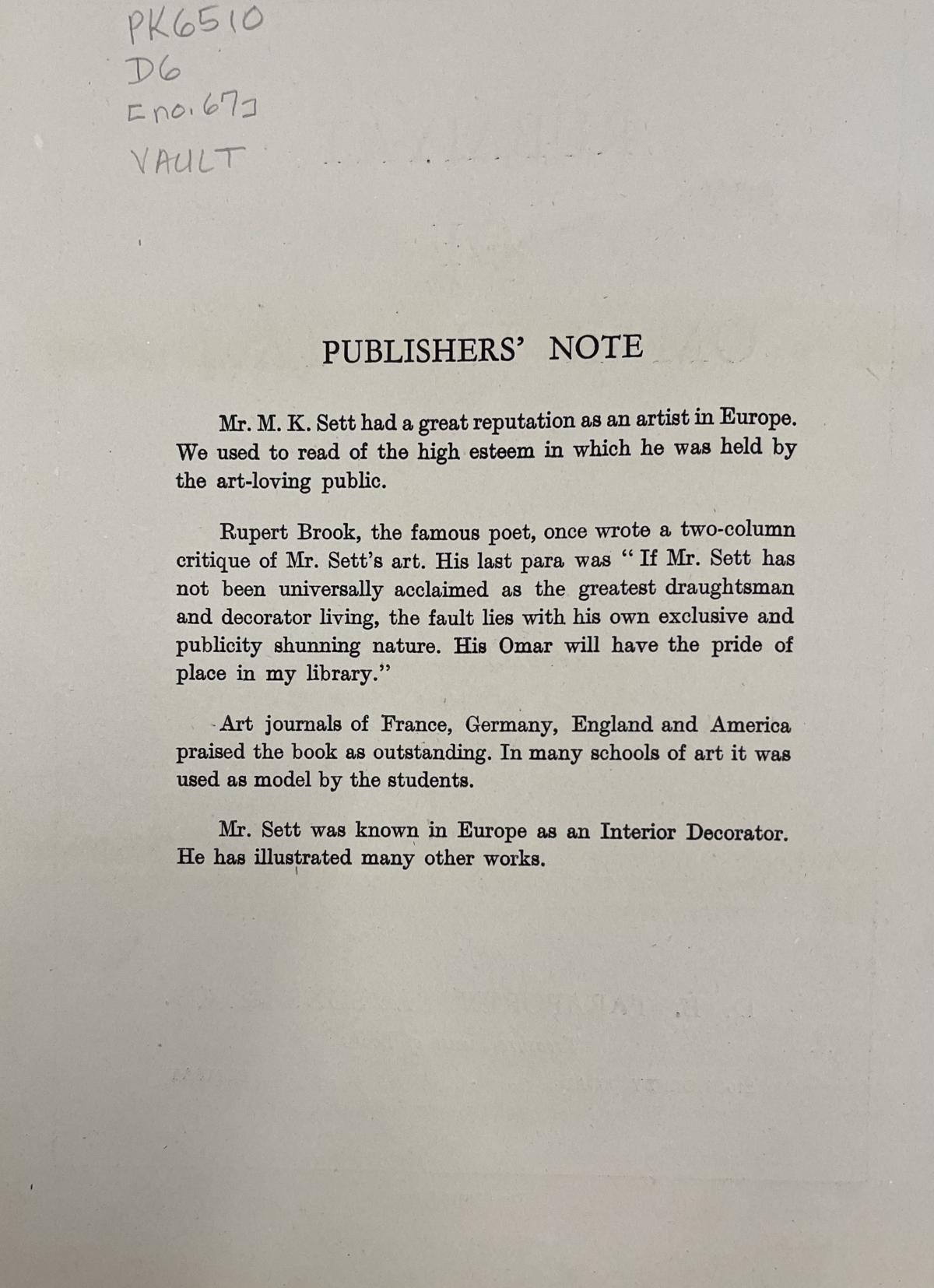Though this edition of Rubáiyát of Omar Khayyám praises the illustrator M.K. Sett in the Publishers’ Note as someone with “a great reputation as an artist in Europe” (see fig. 0), there exists very little archived information on his personal and professional life and works. Referring again to the Publishers’ Note, it is stated that “Mr. Sett was known in Europe as an Interior Decorator” and has “illustrated many other works.”
This particular edition exists as a reprint of Sett’s first illustrated edition, an octavo whose private printing and publication was reported to be funded by Sett’s father. In the foreword of the first edition, published by Galloway & Porter in Cambridge in 1914, Sett states that “some of the English publishers found the work ‘too shocking’… They were ready to bring out my Omar if I changed a few pictures at their dictate and tastes, but I would not so much as a single line or a dot. It seems the English (according to the publishers) would rather have the conventional fig-leaf than a cluster of roses.” It is interesting here to note that this foreword is not present in the re-print dated around 1946 and published by D.B. Taraporevala Sons & Co. in Bombay (present day Mumbai). Instead, what takes its place is the introduction by the illustrator highlighting the miserable state of the art world, and the previously mentioned Publishers’ Notes that signifies a great reception in the American and European cultures that were once condemning the “scandalous” nature of the art in its first publishing (see fig. 1 for example of such art). There is even an included quote from Rupert Brooke, an English poet known for his patriotic pre-WWI sonnets, perhaps to signify the extent of the American/European adoption of this edition and its illustrations.
The re-print is quite different from the original, as it is physically larger (existing as a folio) and is unbound, with green and red ink on the illustrations and text rather than the original’s black and white rendering. The illustrations are reminiscent of the Art Nouveau and Art Deco movements (presumably the movements within which Sett was also being praised as an interior designer), but Sett uses the introduction of the second edition to deny any plagiarism of or even inspiration taken from Aubrey Beardsley, a well-known artist who contributed greatly to the Art Nouveau era.
Information on Sett himself beyond any reference to his work is hard to come by—the only existing personal facts about him are related to his illustration, as it is mentioned that he depicts many women in his illustrations with traditional Parsi clothing, drawing on his own Parsi heritage.
This edition of Rubáiyát was published in present day Mumbai, India, by D.B. Taraporevala Sons & Co., with their offices being at 210 Hornby Road. Hornby Road served as a central area of Bombay, often considered to be a place where India’s elite and wealthy foreigners purchased goods, including books. D.B. Taraporevala Sons & Co. where booksellers along with book publishers and their products were considered high-end and marketed as such.
This publication history implies a story––one that can only be fragmentary due to the lack of information available. While the first edition of Sett’s illustrations was published privately, with his father’s funding and a rejection from English publishers based on the style of drawing, the second is larger, in-color, and published at an established press, marketed towards the very same people who rejected it despite no visible change in the illustrations themselves. This leaves much to be considered, but implies a shift between 1914 and 1946 in which Sett’s artistry could not only be allowed in print, but advertised to upper class figures.
Works Cited
“Bird’s-Eye View (Bombay).” Paper Jewels: Postcards from the Raj, https://www.paperjewels.org/postcard/birds-eye-view-bombay. Accessed 14 May 2023.
“Books to be Exhibited at the Abu Dhabi International Book Fair 2018.” Peter Harrington, https://www.peterharrington.co.uk/blog/wp-content/uploads/2016/09/Abu-D…, pp. 75. Accessed 14 May 2023.
Khayyám, Omar. Rubáiyát of Omar Khayyám. Translated by Edward Fitzgerald, illustrated by M.K. Sett, D.B Taraporevala Sons & Co., circa 1946.
“Musical and Literary Homages and Dedications.” Sorabji Resource Site, https://roberge.mus.ulaval.ca/srs/01-homag.htm. Accessed 14 May 2023.
“Pictorial Bombay.” METROMOD, https://archive.metromod.net/viewer.p/69/2951/object/5140-12057990. Accessed 14 May 2023.
Shatadeep Maitra, “The Three Indian Illustrators of the Rubaiyat: A Book Transcending Cultures and Time.” DAG, https://dagworld.com/the-three-indian-illustrators-of-the-rubaiyat.html. Accessed 14 May 2023.



